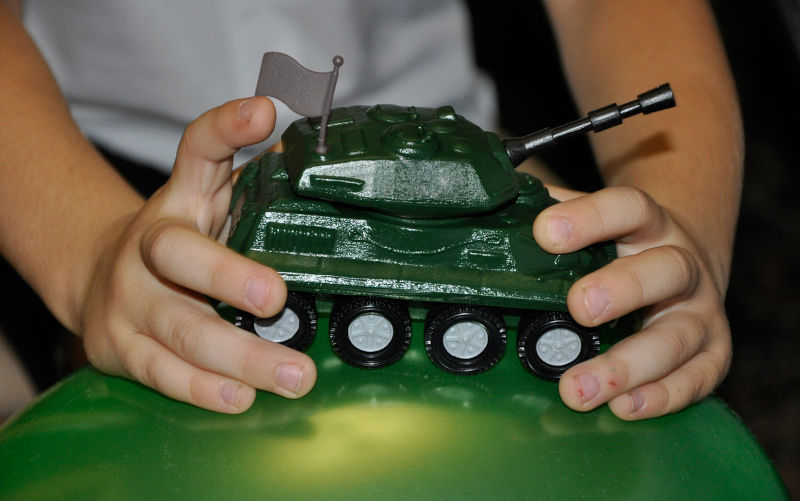Any activity trying to create an inherent ‘goodness’ about engaging in warfare is in no way an admirable activity. Creating game-play interactives of real-life devastation of civilians that invite children to ‘compete’ is reprehensible. Doing so with no realistic acknowledgement of the human cost is utterly, deeply contemptible.
Andrew Fraser’s very noteworthy article recently in P&I shines a light – albeit slightly obliquely – on developments in Australian strategic policy that need to be recognised and negated.
That article references previous articles in P&I from Dr Sue Wareham, President of MAPW, and myself. Both of us have written more than once about facets of changes of presentation and priority at the AWM in recent times, and for some, our recent contributions will amount to little more than beating a familiar drum.
‘Beating a familiar drum’, I agree with. ‘Amounting to little more than’, I argue, deserves further attention.
The AWM is, per se, a cultural institution born of a momentous event of world significance, that commemorates those who served and were sacrificed and honours and explains the actuality of that service and sacrifice. That service and sacrifice has become synonymous with an ‘Australian’ ethic and persona – ‘The ANZAC Spirit’.
Many countries have a shibboleth of a (mythical) persona with qualities required to be admired. For the USA, it is roughly: ‘Flag, Mom, Apple Pie’; for the British it is ‘Stiff Upper Lip’ and ‘How you Play the Game’ (of late, subject to variation…). ‘The ANZAC Spirit’ is rather more permanently inscribed on Australian souls – or so we are commanded to believe.
So often we hear the term ‘sacred’, or even ‘most sacred’ binding the AWM to ‘The ANZAC Spirit’. This is both wrong and stupid – the AWM is not consecrated, by intent. In fact, the phrase is more often than not used by those seeking some advantage for themselves or their close interests by proclaiming this false sacrament. Those who protest their patriotism too much frequently seek to wallpaper over some less than admirable activity.
Any activity trying to create an inherent ‘goodness’ about engaging in warfare is in no way an admirable activity. Creating game-play interactives of real-life devastation of civilians that invite children to ‘compete’ is reprehensible. Doing so with no realistic acknowledgement of the human cost is utterly, deeply contemptible.
One is left to wonder if there is not more than a mere whiff of the Jesuit doctrine (stolen from Aristotle): ‘ Give me a child till he is seven years old,’ said St Ignatius Loyola, ‘ and I will show you the man.’ Surely not? So why would this suspicion arise?
There used to be an old, cynical, Vietnam-war protest wry joke: Join the Army; travel to exotic, distant lands; meet exciting, unusual people and kill them. There is a portrait in the AWM that exemplifies this sentiment – but was never intended as a joke. The true reason(s) for its presence are yet to be exhumed but it is fairly obvious that there are dots to be connected.
Prima facie, one could accept that this and other youth-focused initiatives from the Memorial, such as ‘Name the Cranes’ nonsense of recent days, (passed off as a light-hearted move to make school children ‘stakeholders’ in the foul development project), are simply visitor marketing activities. All of this shows that the current management of the AWM is either stupefyingly ignorant of the real purpose of the institution and the need to respect its position as a part of our social history, or wilfully perverting it to justify the tawdry entertainment park towards which it is being propelled.
However, there are much larger players in the game of using the AWM as the polish on the excremental nature of their existence.
It would be easy but ingenuous to postulate a conspiracy theorist position; it is far more likely to simply be an extremely cohesive confluence of interests. Opening the floodgates to armament manufacturer ‘donations’ to the AWM created opportunity that had not existed before for them to shuffle under the ANZAC Cloak in the Nelson-Stokes era.
And then – inevitably – we have AUKUS as the new glue on the block. Everybody, it seems, wants a piece of the action: the mainstream media, Universities, Industry peak bodies, local, State and of course the Federal government (whichever one in power). The sheer magnitude of the money involved evidently obscures the horrendous potential of pugnacious geo-strategic positioning – and now we have the AWM moulding a positive opinion in children to that potentiality.
No, it is nothing like the Youth Movements of notorious fascist regimes, but schoolkids being fed a false appreciation of warfare now are voters in less than 10 years’ time – about when AUKUS and its boundless materiel acquisition offshoots will really kick in if we do not nip the whole movement in the bud. The intervening period is not long in terms of the existence of most of the major armament manufacturers… for example, Boeing started producing the B-52 – still the strategic bomber de jour for the US military – more than 70 years ago. The B-52s to be located at Tindal airbase are not there as museum pieces.
From an armament manufacturer’s perspective, making friends of future Australian voters is an investment. To the AWM, those kids are the parents of the future, potential visitors. For governments, they will be electors to be courted. For Universities, they are students for AUKUS-aligned studies…
None of these interests would admit to such cynical motives, and indeed, the appeal is mostly nascent at the moment. A seed is sown, investment is made and laid.
It never hurts to have a base of friends, does it?

Richard Llewellyn
Richard Llewellyn was Registrar at the Australian War Memorial from 1986 to 1995.
